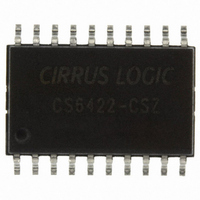CS6422-CSZ Cirrus Logic Inc, CS6422-CSZ Datasheet - Page 20

CS6422-CSZ
Manufacturer Part Number
CS6422-CSZ
Description
IC SPEAKERPHONE ENHANCED 20SOIC
Manufacturer
Cirrus Logic Inc
Type
Audio Processorr
Datasheet
1.CS6422-CSZ.pdf
(48 pages)
Specifications of CS6422-CSZ
Package / Case
20-SOIC
Applications
Speakerphones
Mounting Type
Surface Mount
Product
General Purpose Audio Amplifiers
Available Set Gain
34 dB
Thd Plus Noise
0.03 %
Operating Supply Voltage
5 V
Supply Current
10 mA, 50 mA
Maximum Operating Temperature
+ 70 C
Mounting Style
SMD/SMT
Audio - Load Impedance
10 KOhms
Input Offset Voltage
2.12 V
Minimum Operating Temperature
0 C
Supply Voltage (max)
5.5 V
Supply Voltage (min)
4.5 V
Rohs Compliant
Yes
Operating Temperature Range
0°C To +70°C
Digital Ic Case Style
SOIC
No. Of Pins
20
Lead Free Status / RoHS Status
Lead free / RoHS Compliant
Lead Free Status / RoHS Status
Lead free / RoHS Compliant, Lead free / RoHS Compliant
Other names
598-1200-5
Available stocks
Company
Part Number
Manufacturer
Quantity
Price
Company:
Part Number:
CS6422-CSZ
Manufacturer:
CIRRUS
Quantity:
61
Company:
Part Number:
CS6422-CSZ
Manufacturer:
CIRRUS
Quantity:
4
Part Number:
CS6422-CSZ
Manufacturer:
CIRRUS
Quantity:
20 000
Company:
Part Number:
CS6422-CSZR
Manufacturer:
CREE
Quantity:
210
3.5.1
3.5.2
3.5.3
3.5.4
3.5.5
3.5.6
20
20
RHDET - RECEIVE HALF-DUPLEX DETECTION THRESHOLD
RSTHD - RECEIVE SUPPRESSION THRESHOLD
NSERMP - NOISE ESTIMATOR RAMP RATE
HDLY - HALF-DUPLEX HOLDOVER DELAY
HHOLD - HOLD IN HALF-DUPLEX ON HOWL
TDSRMP - TX DOUBLE-TALK SUPPRESSION RAMP RATE
The sensitivity of the speech detector controls channel switching and ownership in half-duplex mode.
The receive speech detector registers speech if the receive channel signal power is RHDet above the
noise floor for the receive channel.
This parameter sets the threshold for far-end speech detection for disengaging receive suppression.
The speech detector that disengages the receive suppression has its sensitivity controlled by RSThd.
The suppression is inserted into the receive path unless signal from the far-end exceeds the receive
channel noise power by RSThd, in which case speech is assumed to be detected and the suppression
is defeated until speech is no longer detected. Decreasing RSThd to make the speech detector more
sensitive could result in false detections due to spurious noise events which may cause an unpleasant
noise modulation at the near-end. Increasing RSThd makes it robust to spurious noise, but may sup-
press weak far-end talkers. RSThd does not affect the ability of the receive suppressor to attenuate
residual network echo.
The background noise power estimators increase at a programmable rate until the background noise
power estimate equals the current input power estimate. The background noise power estimators
quickly track drops in the current input power estimate. Choose large values of NseRmp if the envi-
ronment is expected to have rapidly varying noise levels. Choose small values of NseRmp if the en-
vironment is expected to have relatively constant noise power.
After a channel goes idle in the half-duplex mode of operation, a change of channel ownership is in-
hibited for HDly in order to prevent false switching due to echoes. The half-duplexor will be more im-
mune to false switching if this delay is longer, but it will also prevent a fast response to legitimate
channel changes. Short values of HDly mimic a more full-duplex like behavior, but may be succepti-
ble to false switching due to echo.
This is a control flag which, if enabled, holds the system in half-duplex when a howl event is detected.
The system may transition to full-duplex if the flag is subsequently cleared. The default state of HHold
is ‘disabled’, thus when a howl is detected, the CS6422 will temporarily drop into half-duplex, retrain,
and transition back into full-duplex on its own.
When “Tx Double-talk Suppression attenuation” (TDbtS, Register 3) is set to a non-zero value, the
CS6422 will introduce a programmable amount of attenuation into the transmit path during a double-
talk event, that is, when the near-end talker and far-end talker are speaking simultaneously. TDSRmp
controls the decay rate of the transmit double-talk attenuation (the attack rate is ~40 ms).
The ‘slow’ setting of TDSRmp results in an attenuation decay rate of about 1 second. The ‘normal’
setting of TDSRmp results in an attenuation decay rate of about 100 ms.
CS6422
CS6422
DS295F1

















